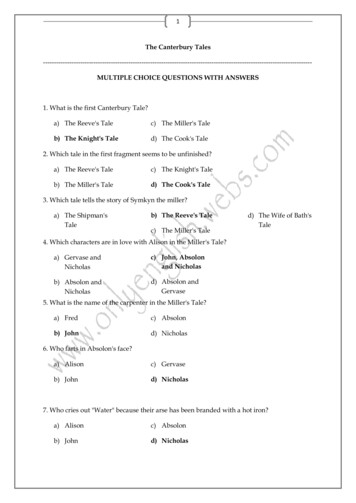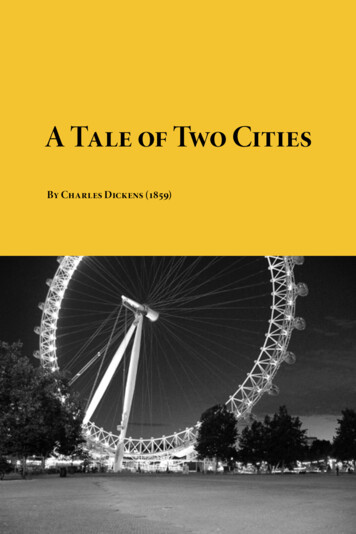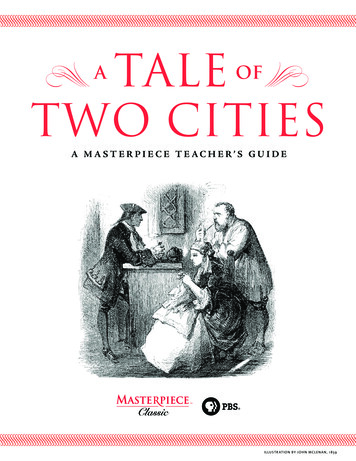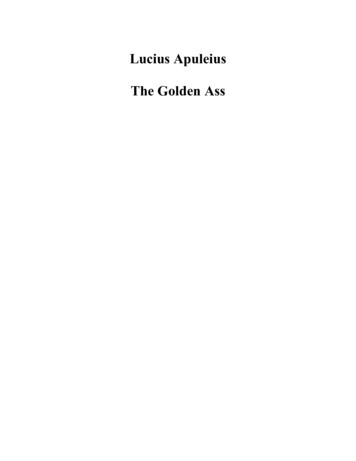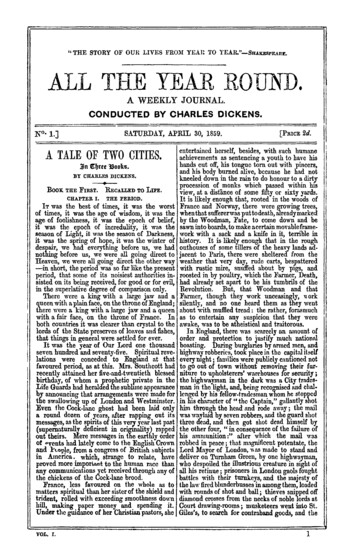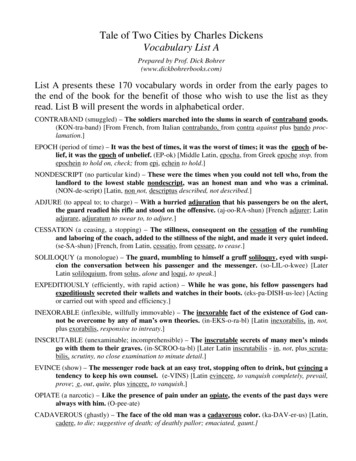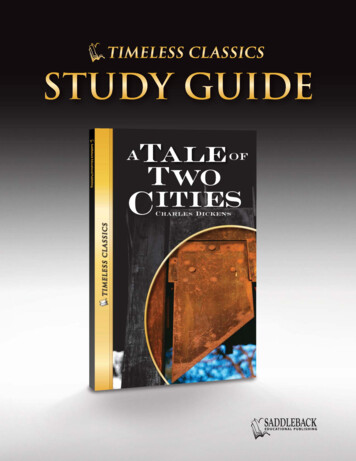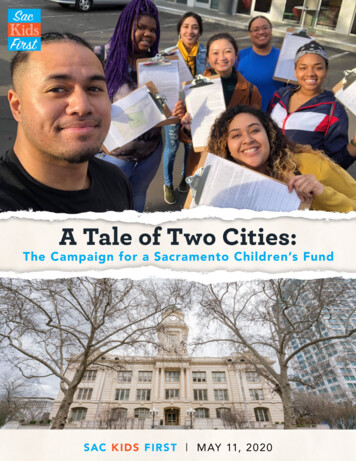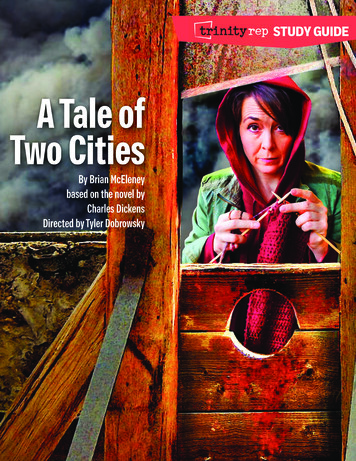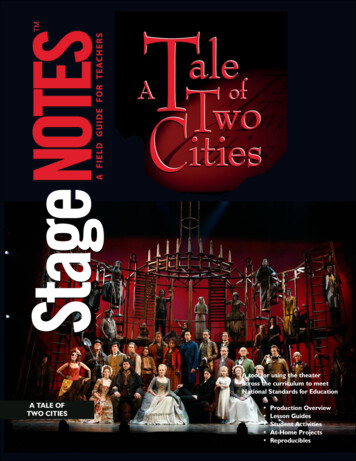
Transcription
A tool for using the theateracross the curriculum to meetNational Standards for EducationA TALE OFTWO CITIES Production OverviewLesson GuidesStudent ActivitiesAt-Home ProjectsReproducibles
Copyright 2008, Camp Broadway, LLCAll rights reservedThis publication is based on A Tale of Two Cities with book, music and lyrics byJill Santoriello and direction by Warren Caryle. The content of the A Tale of TwoCities edition of StageNOTES : A Field Guide for Teachers is fully protectedunder the copyright laws of the United states of America and all other countrieswith which the United States has reciprocal copyright relations. All rightsregarding publishing, reprint permissions, public readings, and mechanical orelectronic reproduction, including but not limited to, CD-ROM, informationstorage and retrieval systems and photocopying, and the rights of translation intoforeign languages are strictly prohibited.Printed in the United States of AmericaFirst Digital Edition: July 2008For more information on StageNOTES and other theatre arts related programs,contact:Camp Broadway, LLC336 West 37th Street, Suite 460New York, New York 10018Telephone: (212) 575-2929Facsimile: (212) 575-3125Email: info@campbroadway.comwww.campbroadway.com
Table ofContentsUsing the Field Guide and Lessons.4List of Characters and Synopsis.5Overture to HISTORY.8History Discussion Lesson.11History Writing Lesson.12History Experiential Lesson.13History After Hours Lesson.15Overture to LANGUAGE ARTS.16Language Arts Discussion Lesson.19Language Arts Writing Lesson.20Language Arts Experiential Lesson.21Language Arts After Hours Lesson.22Overture to LIFE SKILLS.23Life Skills Discussion Lesson.26Life Skills Writing Lesson.27Life Skills Experiential Lesson.28Life Skills After Hours Lesson.29Overture to BEHAVIORAL STUDIES.30Behavioral Studies Discussion Lesson.33Behavioral Studies Writing Lesson.34Behavioral Studies Experiential Lesson.35Behavioral Studies After Hours Lesson.36Overture to THE ARTS.37The Arts Discussion Lesson.39The Arts Writing Lesson.40The Arts Experiential Lesson.41The Arts After Hours Lesson.42A Tale of Two Cities Resources.43
Using theField GuideCamp Broadway is pleased to bring you this A Tale of Two Cities edition ofStageNOTES , the 29th in our series. We are proud to be affiliated with this sweeping musicalthat will debut on Broadway during the 2008 Season. This guide has been developed as a teachingtool to assist educators in the classroom who are introducing the story in conjunction with the stageproduction.By using StageNOTES , you will understand how A Tale of Two Cities chronicles the events knownas The French Revolution (History), expands our vocabulary (Language Arts), illuminates the humancondition (Behavioral Studies), aids in our own self-exploration (Life Skills) and encourages creativethinking and expression (The Arts).The Camp Broadway creative team, consisting of theater educators, scholars, researchers and theaterprofessionals, has developed a series of lesson plans that, although inspired by and based on the musicalA Tale of Two Cities, can also accompany class study. To assist you in preparing your presentation ofeach lesson, we have included: an objective; excerpts taken directly from the script of A Tale of TwoCities; a discussion topic; a writing assignment; and an interactive class activity.The reproducible lessons (handouts) accompany each lesson unit, whichcontains: an essay question; a creative exercise; and an “after hoursactivity” that encourages students to interact with family, friends,or the community at large.The curriculum categories offered in the A Tale ofTwo Cities study guide have been informed by thebasic standards of education detailed in ContentKnowledge: A Compendium of Standards andBenchmarks for K-12 Education, 2nd Edition,written by John S. Kendall and Robert J.Marzano (1997). This definitive compilationwas published by Mid-Continent RegionalEducation Laboratory, Inc. (McREL)and the Association for Supervision andCurricular Development (ASCD) after asystematic collection, review and analysisof noteworthy national and state curriculardocuments in all subjects.The A Tale of Two Cities study guide is foryou, the educator, in response to yourneed for a standards-compliant curriculum.We truly hope this study guide will helpyou incorporate the themes and contentof A Tale of Two Cities into your classroomlessons.Lisa PoelleProducing Director4
List ofCharacters and SynopsisSydney CartonLucie ManetteCharles DarnayDr. Alexandre ManetteMadame Therese DefargeErnest DefargeMr. Jarvis LorryMiss ProssJerry CruncherMr. John BarsadGaspardGabelleMarquis St. EvremondeStryverAttorney General/CronieCronieMrs. CruncherJudge/TurnkeyLittle LucieLittle GaspardSeamstressYoung ManEnsembleAfter 17 years of unjust and secret imprisonment in France, Dr. Alexandre Manette is released from theinfamous Bastille and given over to the care of his former servant, Ernest Defarge, and his wife, MadameDefarge. The Defarges send for Manette’s daughter, Lucie, to retrieve him. No one knows why the doctorwas imprisoned many years ago; Manette has lost his memory and can offer no explanation. Meanwhile, theDefarges don’t hesitate in showing Manette to others as an inspiration for the revolution they hope to incite. InParis, Manette and Lucie are united and she promises to help him build a new life in England.On their voyage home, Lucie and Dr. Manette are befriended by a young Frenchman, Charles Darnay.Darnay, the nephew of the despised Marquis St. Evremonde, has renounced his inheritance and is attemptingto distance himself from the Marquis. Another passenger on the ship is John Barsad, a spy in the service of theMarquis. To ensure his nephew will never return to France, the Marquis gives Barsad false documents to plantin Darnay’s belongings, incriminating Darnay as a spy against England. Upon their arrival in England, Darnay isarrested and brought to trial.At Darnay’s trial for treason, he is rescued by the efforts of a drunken but brilliant lawyer, Sydney Carton - alost soul, cynical and self-loathing. He falls in love with Lucie Manette, who shows him an understanding andcompassion he has never known. But Lucie’s heart is with the Frenchman, and although Dr. Manette hasmisgivings about Darnay, he gives his blessing and Darnay and Lucie are married.Soon after, they are blessed with a daughter. Carton never stops loving Lucie;he remains a close friend to them both and loves their daughter with aspecial tenderness.The murder of Darnay’s uncle, the Marquis, and the pleas ofan old friend lure Darnay to France just as revolution begins.Upon his arrival in Paris, Darnay is arrested and chargedwith crimes against the people as a former aristocrat.Dr. Manette and Lucie follow Darnay to Paris andat the trial Manette speaks for his son-in-law andwins his freedom. But Madame Defarge haltsthe celebration, producing a letter that Manettewrote in the Bastille. The letter tells the story ofManette’s imprisonment and ends with Manette’sbitter curse on the Evremonde family. Thecrowd turns on Darnay and condemns him todeath by guillotine.Sydney Carton arrives in Paris to help Lucie andher family. Carton discovers he can gain accessto Darnay through the spy John Barsad, nowworking in France. He also learns that MadameDefarge is not finished and plans to come afterLucie and the rest of her family. Fueled by theknowledge of this threat, Carton springs intoaction and makes arrangements for them to fleeParis. He then goes to the prison and tells Darnaythat he has a plan to return him to his family butrefuses to reveal it and begs Darnay to do exactly ashe says. Darnay agrees and the story moves swiftly toits surprising and unforgettable conclusion.5
Using theLessonsEach Lesson Unit (History, LanguageArts, etc.) contains the followingLessons:Discussion:The focus is on facilitating an in-depthclass dialogue.Writing:The focus is on the expression ofthoughts in written form.Experiential:The focus is on understanding socialdynamics as well as collaboration andteamwork in small and large groups.A take-home “After Hours” lessonEach StageNOTES lessongenerally includes the followingcomponents:Objective:An overall note to the teacher outliningthe goals of the lesson to follow.From the script:An excerpt or situation from the scriptof A Tale of Two Cities to help “set thestage” for the activity that follows.Featured Lesson Units1 History2 Language Arts3 Behavioral Studies4 Life SkillsExercise:A detailed description and instructionsfor the activity to be facilitated in class.Teaching Tips:Direct questions teachers may use tohelp guide the students through theactivity.5 The ArtsThe Standards listed throughout the StageNOTES Field Guide are excerpted from Content Knowledge: A Compendiumof Standards and Benchmarks for K-12 Education (2nd Edition) by John S. Kendall and Robert J. Marzano, publishedby Mid-Continent Regional Educational Laboratory, Inc. (McREL) and the Association for Supervision and CurricularDevelopment (ASCD), 1997.
TheGuide toTheatergoing EtiquetteIn the early part of the nineteenth century, theatricalperformances usually began at six o’clock. An eveningwould last four or five hours, beginning with a short“curtain raiser,” followed by a five-act play, with othershort pieces presented during the intermissions. Itmight be compared roughly to today’s prime-timetelevision, a series of shows designed to pass thetime. With no television or radio, the theater was aplace to find companionship, light, and warmth on acold winters evening.As the century progressed, the theater audiencereflected the changing social climate. More well-to-dopatrons still arrived at six o’clock for the full programof the evening, while half price admission was offeredat eight or eight-thirty to the working class. Thisallowed for their longer workday and tighter budgets.Still, the theaters were always full, allowing peopleto escape the drudgery of their daily lives and enjoythemselves.Because of this popularity, theaters began to bebuilt larger and larger. New progress in constructionallowed balconies to be built overhanging the seatsbelow—in contrast to the earlier style of recedingtiers. This meant that the audience on the main floor(the section called “the orchestra”) were out of theline of sight of the spectators in the galleries. As aresult, the crowds became less busy peoplewatchingand gossiping among themselves, and more interestedin watching the performance. The theater managersbegan the practice of dimming the lights in the seatingarea (called the “house lights”), focusing the attentionof the audience on the stage. The advent of gaslighting and the “limelight” (the earliest spotlights)made the elaborate settings even more attractive tothe eye, gaining the audience’s rapt attention.By the 1850s, the wealthier audiences were nolonger looking for a full evenings entertainment.Curtain time was pushed back to eight o’clock (forthe convenience of patrons arriving from dinner);only one play would be presented, instead of four orfive, freeing the audience for other social activitiesafterward. Matinee (afternoon) performances werenot given regularly until the 1870s, allowing societyladies, who would not have ventured out late at night,the opportunity to attend the theater.Now in a new millennium, many of these traditionsare still with us. The theater is still a place to “seeand be seen”; eight o’clock is still the standard curtaintime; and the excited chatter of the audience falls toa hush when the house lights dim and the stage lightsgo up, and another night on Broadway begins.You can make sure everyone you know has the verybest experience at the theater by sharing this TheaterEtiquette with them. And now, enjoy the show!Beinga Good AudRememiencemovie ber, going to. Therthethewhenyou’re are some dif eater isn’t likefeat a live perfo rent rules t going to ao keepBelievermance.in mindThe sa it or not, the actome acors canhear thusticsteaan aud actors mea hat make it p ctually heaience mns thatr you.ossiblephones ringin akes: talking they can hea for you to,rtheregis no f . That’s why unwrapping all the noise, whenood otreatsscandy, crathe mu t intermissio drink at yo you’re at a s ellhon; saveultiplex)the po r seats (eat w,pcornyNo tamunch ourlking forthe pe ing (even ifrson next to you’re just eyou)xplaininAlwayg the ps keeplot to(This ecellphoneven mseshow to tell t ans no textin and beeperhem how gre g your friend s turned offs durinat it is.Of coug therse, w.)hat theyou’reelaugh a njoying the actors like toptyour b the funny p erformance. hear is howarts, claiggestmuchSo gochactorsapat the eers and ap for the son head andcurtainwell dopgsne.call. Th lause for you , and saver faat’s their proo voritef of a job
Overture toHistoryIt was the best of times. . .It was the worst of times. . .it was the age of wisdom, it was the age of foolishness, it was the epoch of belief, it was theepoch of incredulity, it was the season of Light, it was the season of Darkness, it was the springof hope, it was the winter of despair, we had everything before us, we had nothing before us.The French Revolution, backdropfor A Tale of Two Cities, is eloquentlydescribed as a rather schizophrenicevent by Charles Dickens, andappropriately so. His original novel onwhich the musical is based was writtenjust a bit over 50 years after the bloodyFrench upheaval that both inspired theworld with its cry for Liberty, Equality,Fraternity, and horrified it with thesubsequent relentless bloodlust of theguillotine. Generally viewed as a questfor freedom by anSummary of Standard foroppressed peasantHistorical Understanding1. Understanding and analyzingminority, the causeschronological relationships andpatterns:of the revolutionAnalyze influence of specific beliefsare far moreon these times. How would eventsbe different in the absence of thesecomplex.beliefs?It is ironic, however, to note that historians ingeneral mark the French Revolution as the end ofthe period of Enlightment. The grisly murder ofthousands of French citizens can hardly be seen as“enlightened” behavior.Other more complex causes for the Revolutioninspire debate even today. Some historiansattribute initial political unrest to debts incurredthrough France’s numerous wars, and thesubsequent heavy taxation that resulted. Othersinsist the country at the time was still one of therichest and most powerful in Europe. Perhaps itwas the way the country distributed its money asnAnalyze the effects specficdecisions had on history. Howwould things have been differentin the absence of these specificdecisions?n2. Understanding the historicalperspective:Understand that the consequencesof human intentions are influencedby the means of carrying them out.nUnderstand how the past affectsour private lives and society ingeneral.nPerceive past events with historicalempathy.nEvaluate credibility andauthenticity of historical sources.nEvaluate the validity andcredibility of different historicalinterpretations.nIt is true theEnlightenmentundoubtedly led manyEuropean writers tocriticize Louis XVI whileforwarding democraticideas. The ideas of theEnlightenment did alsoespouse greater rightsfor common peopleand questioned thedivine right of kings torule. Many see it as thebeginning of the endfor a French monarchyalready on shaky ground.8
opposed to how much it actuallyhad that irritated peasants and thecommercial class alike—a volatile mixof enemies for any government.Another factor was Louis’s wellpublicized ill treatment of theunderclass. History insists that thegeneral populations of most otherEuropean powers had far less freedomand a much greater chance of crueland arbitrary punishment than did theFrench at the time. So it is unlikelythat Marie Antoinette’s ill-timedremark, “Let them eat cake,” inresponse to peasant demands for breadalone resulted in the toppling of themonarchy, and 40,000 French citizensbeing sent to the guillotine. In fact,at the time Louis called the EstatesGeneral in 1789 (the date cited as theofficial onset of the revolution), he wasconsidered generally popular, thoughmany of the nobility and his ministerswere not.“Let them eat cake!”—Marie AntoinetteIn the end, the Ancien Régime waslikely brought down by its blindnessto a politically changing world (The American Revolution was already over). It also seemed oblivious tothe unholy alliance forming among an ambitious middle class seeking power and disgruntled peasantsand working class citizens tired of struggling and of being poor. These alliances quickly dissolved andconflicting interests of the various groups led to the bloodshed epitomized by the Reign of Terror.1788to1799Timeline of the French RevolutionAugust1788Louis XVIannouncesmeeting ofthe EstatesGeneral inMay 1789May 5,1789June 17,1789June 20,1789July 14,1789July 20,1789August 26, October 5, February,178917891790Estates- Third Estate Oath of Storming of Revolt of the Declaration Parisian MonasteriesGeneraldeclaresthe Tennis the Bastille peasantry of the Rights womenandconvenesitself theCourtbeginsof Man and march toconventsNationalCitizenVersailles; dissolvedAssemblyissuedLouis XVIreturns toParis9
Reign of Terror—In the Shadow of the Guillotine“Terror is nothing other than justice, prompt, severe, inflexible”—Maximilien RobespierreA Tale of Two Cities is set during the Reign of Terror,an 11-month period of the revolution between1793 and 1794. The glorious goal of Liberté,Egalité, and Fraternité was quickly usurped byRobespierre, mastermind of a bloody witch huntthat ensued. First the royalists were beheaded,then the moderate Girondists. It was only a matterof time before anyone accused, rightly or wrongly,of past association with the monarchy or nobilitywas sentenced to the guillotine. Estimates put thenumber of people beheaded throughout Franceat between 30,000 and 40,000. As in the case ofMadame Defarge, if one had an enemy, or helda particular grudge, the guillotine became theweapon of choice.Designed to fight the enemies of the revolution,The reign’s stated goal was to prevent counterrevolution from gaining ground. Contrary topopular belief, most of the people rounded upwere not aristocrats, but ordinary people. Aman (and his family) might go to the guillotine forbeing overheard by an informant criticizing thegovernment. Watch Committees were encouragedto arrest “suspected persons,” . those who eitherby their conduct, relationships, speech or writingwere deemed enemies of liberty. (Law of Suspects,1793) Civil liberties were suspended. Thepromises of the Declaration of the Rights of Man,written at an earlier stage of the revolution, wereforgotten. Terror was the order of the day.“Softness to traitors will destroy us all”—Maximilien Robespierre1788to1799Timeline of the French RevolutionJuly1790June1791April1792August 10,1792January1793July1793CivilLouis XVIFranceStorming of Louis XVI MaximilienConstitution and family declares war the Tuileries executed Robespierreof theattempt to on AustriaassumesClergyflee Parisleadership ofissuedare capturedCommitteeand returnedof PublicSafety1793 1794Reign ofTerror17941794 17991799RobespierreNapoleonguillotined Thermidorian BonaparteReaction overthrowstheDirectoryand seizespower10
HistoryDiscussionDiscussionObjectiveHistory and thejustification of violenceFrom theScriptAct 1, Scene 2Defarge and a man discuss the impending Reign of TerrorDefargeWHEN PEOPLE ARE THIRSTYAND READY AND WILLINGTHEN IT WON’T BE LONGTIL SOMETHING ELSE BUT WINE IS SPILLING.Madame DefargeTHE BUTCHER IS IDLEWHEN PEOPLE ARE STARVING.Teaching TipsTerror is a word wehear a lot of these days.A concise definition:violence or threatsof violence used forintimidation or coercion.Is it ever right toterrorize people in theinterests of the commongood?DefargeBUT IT WON’T BE LONGTIL THERE’S ANOTHER KIND OF CARVING.ExerciseThe justification of violence in the face of injustice is an interesting and complex discussion.There’s an old cliché, “You have to break a few eggs to make an omelet.” The FrenchRevolution broke more than a few “eggs” in its pursuit of liberty and justice. The more than30,000 people put to the guillotine attest to that. But was the Reign of Terror, as Robespierreinsisted, a necessary ingredient in solidifying the revolution?Write on the board:“Terror is nothing other than justice, prompt, severe, inflexible”-- Maximilien Robespierre.Have students read up on Robespierre and his role in the revolution. Remind them thatsome of the people put to the guillotine were guilty of crimes against the people. Given that,conduct a class discussion analyzing the quote and its relevance to the struggle for liberty andjustice. What is the danger to society in general in accepting such a premise? How does thisphilosophy relate to America’s practice of capital punishment? Is the treat of death for certainactions, terror? What is the relationship between terror and power? In their opinion, wasRobespierre supporting the revolution or merely seeking personal power?11
HistoryWritingWritingObjectiveCompare and contrastthe French and AmericanRevolutions.From theScriptAct 2, Scene 3Charles Darnay is on trial for his life. Madame Defarge seeks revenge on Darnay foran atrocity committed before the revolution by someone in his family, the aristocraticEvremondes. She reads in court from a letter written by Dr. Manette while he was in prisondescribing the event he witnessed. These are the last words of a dying young peasantdescribing how his brother-in-law was murdered by the Evremondes.Young ManYOU KNOW THE LAWA PEASANT HAS NO RIGHTSTHE MASTER OWNS YOUR BREATHTeaching TipsRevolution is a messybusiness no matterwhere it occurs. Yetat times in history lifebecomes so unbearablefor people that they feelthey have no choice.What goals are worth it;what goals are not?THEY TOOK THIS MANTHEY TIED HIM TO A CARTAND DROVE HIM TO HIS DEATHExerciseThere were many reasons why the French revolted against their government. Aristocratsbeing too often held above the law was one of many. In America we tend to attribute ourfight for liberty with statements such as, “Taxation without representation is tyranny.” Buteven our revolution was about more than just taxes.Research the causes and motivations for both the American and French Revolutions. As youresearch place the information you find into one of the three categories appearing at the endof this paragraph. Create a category of “Other” for any cause that does not fit into the threeprovided. When finished, write an essay comparing and contrasting the two events fromsocial, political, economic and “other” perspectives.12
HistoryExperientialExperientialObjectiveLearning importanthistorical events insequence.From theScriptAct 1, Scene 2Defarge sings about Manette and the horrors of the Bastille.DefargeUP IN THE GARRET IS A MANWHO LOST HIS MEMORY AND HIS MINDSEVENTEEN YEARS IN THE BASTILLEBUT NO ONE HERE CAN NAME HIS CRIMEHE WAS A DOCTORCALLED AWAY ONE NIGHTTO TRY AND SAVE A LIFEBUT WHEN HE WENT TO HELPTeaching TipsName the three topIvy League Universities.What are the advantagesof attending suchschools? Why are theyso competitive? Why isthere so much prestigeattached to graduatingfrom there?HE VANISHED OUT OF SIGHTExercisePlay “Storm the Bastille.” Make copies of the list of events on the following page. Hand themout to students. Give them a week to study them. On game day no reference notes will beallowed in class. Divide the class into three teams. Names of those on each team will bepulled from a hat to ensure that no one team gets the most conscientious students. Throwdice to determine which team goes first, second, etc.Ask the first team which event is first in the sequence of events. Teams should discuss theanswers before actually answering. If they get it right they get a point. If they don’t, ask thesecond team and so on. If no team knows the answer, withhold the point and give all threeteams a prompt. Go on to the next event. At the end of the game each group tallies its points.Whichever has the most points wins a prize to be pre-determined and pre-announced by theteacher. The prize should be significant; this is a very difficult game.Any student who adds additional information to any event sequence earns five extra pointsfor his or her team.13
Chronological Eventsof the Storming of the Bastille Rumors of attacks from the government and possible starvation are too muchfor angry peasants and the working classes. The enraged Paris Commune is defiant (define Paris Commune when answeringthe question). July 7th, thirty-two Swiss soldiers led by Lieutenant Deflue come to aid Marquisde Launay and prepare for a small mob. The Marquis expects a mob attack but certainly not a siege! The entire workforce of the Bastille has been repairing the Bastille andpreparing for a minor attack from a hundred or so angry citizens. 12 guns, each launching 24-ounce case shots are added. Half past three on July 14, 1789, 300 people marched to the Bastille. 300 guards leave their posts in fear of the mob. The bloodthirsty mob marches to the Bastille, searching for gun powder andprisoners. The mob shouts for the Marquis to lower the draw bridge. De Launay sends a note to the crowd leader, Hulin, that he will blow up thefortress with everyone in it if they do not disperse. They do not disperse. Bridges are lowered; de Launay and his soldiers are captured by the mob anddragged through the streets of Paris. Heads are crudely cut off as they go. Elements of the newly formed National Guard are present at the assault. They try to stop looting but fail. The crowd makes their way to the Hotel de Ville. King Louis XVI at Versailles asks an informer, “Is this a revolt?” La Rochefoucauld-Liancourt answers, “No Sire, it is a revolution.”14
HistoryAfter HoursTeaching TipsChallenge #1“Those who ignore thelessons of history arecondemned to repeat it.”Take some time on yourown to explore areasof history you won’tnecessarily be studying inclass. It will be worth it.Take the initiative. Learnthings on your own.How America Avoided a Reign of Terror, or Did We?If the American revolutionaries were to succeed they needed everyone, or almost everyoneon board. Didn’t they? Yet nothing in history indicates anything close to the French Reign ofTerror ever occurred, either during or after the war. Play sleuthful devil’s advocate. Searchhistory online and see what you can find on coercive behavior on the part of Washington’sarmy or others to force dissenters into line.Challenge #2Check YourVisit the websites below. Take the quizzes. Find out how much you know about the FrenchRevolution? If you don’t know the answers make a guess. It’s a good way to .com/quiz/100601.html?AP rand 1120006110Challenge #3Well. . .He Deserved It!In five sentences (five sentences only) explain who Jean Paul Marat was and why on earthCharlotte Corday killed him?15
Overture toLanguage ArtsThe Mind of Charles DickensCritics insist that Dickens, in writingA Tale of Two Cities, was influencedby other writings that also took acritical view of the French Revolution.He admits (though undoubtedly anexaggeration) to reading Carlyle’sThe French Revolution “five hundredtimes.” So we can assume the criticsare correct. Like Carlyle, Dickensbook clearly reveals he was no “fan” ofrevolution and its violence. He sees nojustice in it. Whether his view is rightor wrong, his novel and the subsequentfilms, television productions and nowBroadway musicalSummary of Standard foradapted from itLanguage Artsconfirm the imageWritingDemonstrates competence in theof the revolutiongeneral skills and strategies of thewriting processas no more thanDemonstrates competence incarnage in therewriting, drafting and revising,editing and publishingminds of readersDemonstrates competence in thesty
The A Tale of Two Cities study guide is for you, the educator, in response to your need for a standards-compliant curriculum. We truly hope this study guide will help you incorporate the themes and content of A Tale of Two Cities into your classroom lessons. Lisa Poelle Producing Director field Guide u sin G the 4

